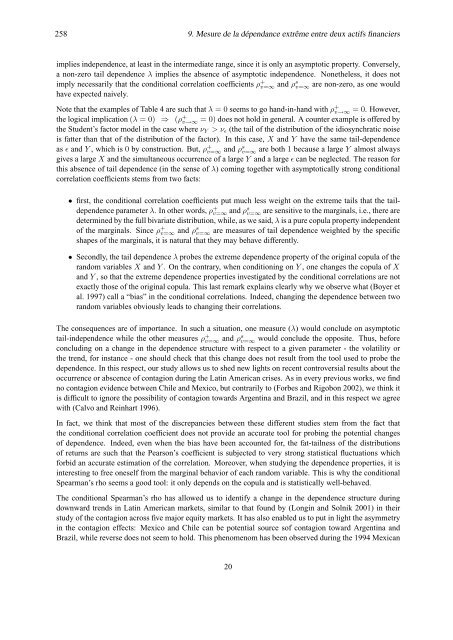statistique, théorie et gestion de portefeuille - Docs at ISFA
statistique, théorie et gestion de portefeuille - Docs at ISFA
statistique, théorie et gestion de portefeuille - Docs at ISFA
Create successful ePaper yourself
Turn your PDF publications into a flip-book with our unique Google optimized e-Paper software.
258 9. Mesure <strong>de</strong> la dépendance extrême entre <strong>de</strong>ux actifs financiers<br />
implies in<strong>de</strong>pen<strong>de</strong>nce, <strong>at</strong> least in the intermedi<strong>at</strong>e range, since it is only an asymptotic property. Conversely,<br />
a non-zero tail <strong>de</strong>pen<strong>de</strong>nce λ implies the absence of asymptotic in<strong>de</strong>pen<strong>de</strong>nce. Non<strong>et</strong>heless, it does not<br />
imply necessarily th<strong>at</strong> the conditional correl<strong>at</strong>ion coefficients ρ + v=∞ and ρ s v=∞ are non-zero, as one would<br />
have expected naively.<br />
Note th<strong>at</strong> the examples of Table 4 are such th<strong>at</strong> λ = 0 seems to go hand-in-hand with ρ + v→∞ = 0. However,<br />
the logical implic<strong>at</strong>ion (λ = 0) ⇒ (ρ + v→∞ = 0) does not hold in general. A counter example is offered by<br />
the Stu<strong>de</strong>nt’s factor mo<strong>de</strong>l in the case where νY > νɛ (the tail of the distribution of the idiosynchr<strong>at</strong>ic noise<br />
is f<strong>at</strong>ter than th<strong>at</strong> of the distribution of the factor). In this case, X and Y have the same tail-<strong>de</strong>pen<strong>de</strong>nce<br />
as ɛ and Y , which is 0 by construction. But, ρ + v=∞ and ρ s v=∞ are both 1 because a large Y almost always<br />
gives a large X and the simultaneous occurrence of a large Y and a large ɛ can be neglected. The reason for<br />
this absence of tail <strong>de</strong>pen<strong>de</strong>nce (in the sense of λ) coming tog<strong>et</strong>her with asymptotically strong conditional<br />
correl<strong>at</strong>ion coefficients stems from two facts:<br />
• first, the conditional correl<strong>at</strong>ion coefficients put much less weight on the extreme tails th<strong>at</strong> the tail<strong>de</strong>pen<strong>de</strong>nce<br />
param<strong>et</strong>er λ. In other words, ρ + v=∞ and ρ s v=∞ are sensitive to the marginals, i.e., there are<br />
d<strong>et</strong>ermined by the full bivari<strong>at</strong>e distribution, while, as we said, λ is a pure copula property in<strong>de</strong>pen<strong>de</strong>nt<br />
of the marginals. Since ρ + v=∞ and ρ s v=∞ are measures of tail <strong>de</strong>pen<strong>de</strong>nce weighted by the specific<br />
shapes of the marginals, it is n<strong>at</strong>ural th<strong>at</strong> they may behave differently.<br />
• Secondly, the tail <strong>de</strong>pen<strong>de</strong>nce λ probes the extreme <strong>de</strong>pen<strong>de</strong>nce property of the original copula of the<br />
random variables X and Y . On the contrary, when conditioning on Y , one changes the copula of X<br />
and Y , so th<strong>at</strong> the extreme <strong>de</strong>pen<strong>de</strong>nce properties investig<strong>at</strong>ed by the conditional correl<strong>at</strong>ions are not<br />
exactly those of the original copula. This last remark explains clearly why we observe wh<strong>at</strong> (Boyer <strong>et</strong><br />
al. 1997) call a “bias” in the conditional correl<strong>at</strong>ions. In<strong>de</strong>ed, changing the <strong>de</strong>pen<strong>de</strong>nce b<strong>et</strong>ween two<br />
random variables obviously leads to changing their correl<strong>at</strong>ions.<br />
The consequences are of importance. In such a situ<strong>at</strong>ion, one measure (λ) would conclu<strong>de</strong> on asymptotic<br />
tail-in<strong>de</strong>pen<strong>de</strong>nce while the other measures ρ + v=∞ and ρ s v=∞ would conclu<strong>de</strong> the opposite. Thus, before<br />
concluding on a change in the <strong>de</strong>pen<strong>de</strong>nce structure with respect to a given param<strong>et</strong>er - the vol<strong>at</strong>ility or<br />
the trend, for instance - one should check th<strong>at</strong> this change does not result from the tool used to probe the<br />
<strong>de</strong>pen<strong>de</strong>nce. In this respect, our study allows us to shed new lights on recent controversial results about the<br />
occurrence or abscence of contagion during the L<strong>at</strong>in American crises. As in every previous works, we find<br />
no contagion evi<strong>de</strong>nce b<strong>et</strong>ween Chile and Mexico, but contrarily to (Forbes and Rigobon 2002), we think it<br />
is difficult to ignore the possibility of contagion towards Argentina and Brazil, and in this respect we agree<br />
with (Calvo and Reinhart 1996).<br />
In fact, we think th<strong>at</strong> most of the discrepancies b<strong>et</strong>ween these different studies stem from the fact th<strong>at</strong><br />
the conditional correl<strong>at</strong>ion coefficient does not provi<strong>de</strong> an accur<strong>at</strong>e tool for probing the potential changes<br />
of <strong>de</strong>pen<strong>de</strong>nce. In<strong>de</strong>ed, even when the bias have been accounted for, the f<strong>at</strong>-tailness of the distributions<br />
of r<strong>et</strong>urns are such th<strong>at</strong> the Pearson’s coefficient is subjected to very strong st<strong>at</strong>istical fluctu<strong>at</strong>ions which<br />
forbid an accur<strong>at</strong>e estim<strong>at</strong>ion of the correl<strong>at</strong>ion. Moreover, when studying the <strong>de</strong>pen<strong>de</strong>nce properties, it is<br />
interesting to free oneself from the marginal behavior of each random variable. This is why the conditional<br />
Spearman’s rho seems a good tool: it only <strong>de</strong>pends on the copula and is st<strong>at</strong>istically well-behaved.<br />
The conditional Spearman’s rho has allowed us to i<strong>de</strong>ntify a change in the <strong>de</strong>pen<strong>de</strong>nce structure during<br />
downward trends in L<strong>at</strong>in American mark<strong>et</strong>s, similar to th<strong>at</strong> found by (Longin and Solnik 2001) in their<br />
study of the contagion across five major equity mark<strong>et</strong>s. It has also enabled us to put in light the asymm<strong>et</strong>ry<br />
in the contagion effects: Mexico and Chile can be potential source sof contagion toward Argentina and<br />
Brazil, while reverse does not seem to hold. This phenomenom has been observed during the 1994 Mexican<br />
20




